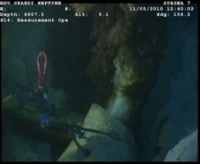The numerous failed attempts to stop oil leaking into the Gulf of Mexico have become a huge embarrassment for the UK’s largest company and have exposed a widespread knowledge gap on the risks associated with deep sea drilling.
BP announced on Tuesday a plan to plug the oil leak using heavy liquids – an operation known as ‘top kill’. According to energy giant, this technique has never been used in such deep water and its success is uncertain. If this fails to stop the flow of oil, it will be one of several unsuccessful attempts tried by BP since the rig blew up in the Gulf of Mexico one month ago.
Ever since the blast, the decisions made by BP, rig owner Transocean and the Halliburton rig crew have been under increasing scrutiny by the US government. What has been made clear is that all parties grossly underestimated the risks associated with drilling for oil in sea beds 5,000 feet (1.5km) below the surface.
In his preliminary findings on the failures that led to the Gulf of Mexico disaster, University of California Berkeley engineering professor Robert Bea could not make any earthbound comparisons to the hazards that could be found in such depths. ‘The hazards are comparable to that of exploration on the Moon and Mars,’ he stated.
The Obama administration has become increasingly frustrated by BP’s repeated failures to prevent the problem from becoming worse. But the company argues it is dealing with an unprecedented situation. Never before has there been a leak in such deep water.
And there don’t appear to be many in the offshore engineering community willing to proffer any alternative ideas for BP to try out.
When The Engineer sought comment on possible technical solutions, we were rebuffed by numerous organisations with offshore expertise, including the Institute of Petroleum Engineering and The National Subsea Research Institute.
The only organisation willing to comment was, perhaps surprisingly, Shell — BP’s biggest competitor. But instead of taking the opportunity to rub its rival’s noses in its millions of gallons of spilled oil, Shell spokesman Rainer Winzenried took a more sympathetic position.
‘As part of the oil industry we are affected as well and we are more than keen to get details of the accident,’ he said.
Winzenried said Shell has interest in how the investigation pans out and how the blame among BP, Transocean and Halliburton will be divided. After all, he said, his company relies on the same contractors as BP.
BP has already outlined a plan in case its ‘top kill’ solution fails. The company announced it could cut the well pipe and insert a cap on its riser to direct most of the oil and gas to a drillship 5,000 feet on the surface above. Another idea proposed by the company is lowering a second blowout preventer on top of the one that failed last month.
While many experts in the field of offshore drilling were reluctant to speak to The Engineer about the BP leak, one possible solution to the problem was proposed by a former engineer for North Sea operator Total E&P.

Scottish engineer Tony Smee, who is now retired after 20 years in the business, suggested the possibility of removing the 21 inch riser pipe from the busted blowout preventer and pouring iron balls down the well using the 4 inch pipe that is at present being used to extract oil.
He said, ‘If the well flow is too strong the balls would be thrown out, then balls or rods of heavier material would be used. The effect of the cascade of steel balls is to increase the average density of the column of oil in the well, similar to the mud normally used to control well pressure, and counterbalance the pressure of the escaping oil.
‘The 21 inch riser now lying on the sea bed would need to be removed above the blowout preventer and a pipe inserted to allow the balls or rods to enter the well. A study of flow rates, density and viscosity will show if iron balls are feasible.’
If the flow rate is too high, Smee suggested using a material such as lead or, what might sound shocking to some, depleted uranium to slow the flow rate.
‘As the well flow slows and balls sink further into the well, smaller and smaller balls will be used as they sink more slowly. By adjusting to a smaller size, perhaps finally to lead shot which is denser than iron, the well flow slows and stops. The well is some 13,000 feet deep the cascade would drift down the well like snowflakes, so there could be more than an hour of opportunity to seal the well.’
With the dearth of practical alternative solutions being suggested by the engineering community, Smee hopes his suggestion is taken into consideration.
Meanwhile the appalling nature of the oil spill disaster has brought forward some equally shocking solutions to the problem. According to reports, Russian newspaper Komsomolskaya Pravda suggested BP try an old Soviet trick for stopping natural gas leaks by detonating a nuclear bomb on the Gulf of Mexico site.
The solution, which was reportedly applied on four natural gas leaks between 1966 and 1981, creates an underground explosion that moves the rock, presses on it and squeezes the well’s channel.
While it may have been successful in stopping natural gas leaks in the Soviet Union, there is no indication from BP or the US government that such drastic measures will need to be taken.





Project to investigate hybrid approach to titanium manufacturing
What is this a hybrid of? Superplastic forming tends to be performed slowly as otherwise the behaviour is the hot creep that typifies hot...